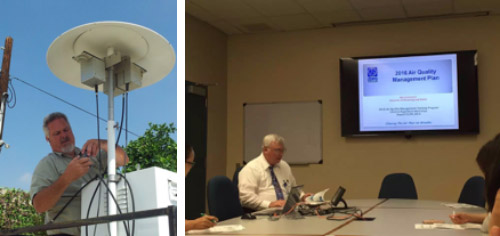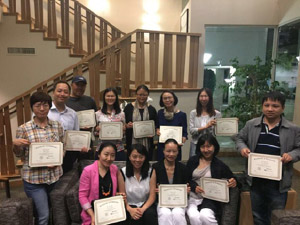Restoring the Blue Sky: 40-Year Lessons from Los Angeles
As a result of local and governmental efforts to control air pollution in Los Angeles, the air quality has greatly improved since the 1970s, cutting down the number of first stage alerts from 100 to less than 10 per year today, representing an exceptional success story in reducing pollutant emission levels.
In collaboration with the South Coast Air Quality Management District (SCAQMD) and the California Environmental Protection Agency Air Resources Board (ARB), UCLA will present snnusl workshops relating California’s experience in combining science and public policy to develop effective air pollution control strategies in efforts to provide for sustainable solutions, ensuring that present and future generations can enjoy breathing in clean air. The training program consists of three days of lecture presentations at UCLA and two days of field trips to ARB and to SCAQMD. Participants of the inaugural training program included representatives from a wide range of organizations in China, including well-known NGOs, environmental industries, governmental agencies, and the media.
Speakers on the first three days used an interactive lecture format, designed to stimulate discussion. The participants were actively engaged, and discussions often sought to that began the process of translating parts of California’s experience into a Chinese context. Discussions were frequent, vigorous, and illuminating for all involved.

The first day covered basic principles and core concepts of air pollution formation, regulation and exposure. The two directors or the Center for Clean Air spoke: Dr Suzanne Paulson and Dr. Yifang Zhu. In the morning, Dr. Paulson introduced the physical and chemical properties of air pollution formation, especially in California, a historical overview of air pollution control, the current of air pollution and future directions for further improvements.
“The training program teaches me that environmental regulation standards should all be health-oriented. The air quality regulatory agencies should cooperate with industries to set up fair competition rules that will not harm the law abiding companies.”
Dr. Zhu spoke in the afternoon, covering air pollution exposure assessment. She emphasized that air pollution exposure is determined by time and space. For urban citizens, the indoor exposure cannot be neglected. Here is the link to Dr. Zhu’s slides.

In the second day, Dr. Beate Ritz from Department of Epidemiology and Dr. Jesus Araujo from Department of Toxicology introduced the health effects of air pollution. Dr. Ritz discussed air pollution-related risks for infants and pregnant women (Dr. Ritz’s slides) and Dr. Araujo introduced the mechanism by which air pollution is associated with cardiovascular and cerebral diseases (Dr. Araujo’s slides).
“The lectures provided by professors are very scientific and understandable. They focus on details that we used to neglect.”
“I really hope more and more air quality research can be conducted in Beijing and in China ”

On the third day, Dr. Rui Wang from School of Public Policy and Dr. Matthew Kahn from the Institute of Environment and Sustainability/Department of Economics focused on air pollution policy and economic research. Dr. Wang’s discussed the relationship between air pollution, traffic, and policies aimed at controlling traffic-related air pollutions in Los Angeles (Dr. Wang’s slides). Dr. Kahn has long been engaged in environmental economics research in China. His lecture explored the relationship between the environment, economics and his previous research findings in China (Dr. Kahn’s slides).
“The training program allows me to have a better understanding about the Los Angeles experience in air pollution control, including the cultural background, the public attitudes, and the regulatory policies”
The three days of presentations and discussions were followed by two days of field trips, for an in-depth look at policy development, monitoring and testing in Los Angeles. The first day’s destination was California Air Resources Board (ARB)’s Haagen Smit Laboratory. In the morning, an ARB manager introduced ARB experience managing emissions from local industries and how to effective strategies to encourage industries to comply with air quality regulations. In the afternoon, the whole group enjoyed a guided tour to the ARB dynamometer testing facility, which is used for vehicle engine emission testing, research, and development and maintenance of the inventory of air pollution emissions in Southern California.
“The professors introduced a lot of latest research trends related with air pollution health effects. Those ideas and findings are very fascinating. I really hope these studies can be also conducted in China.”

The final day of the training program was spent visiting the Headquarters of the South Coast Air Quality Management District (SCAQMD). In the morning, the group visited an example of the SCAQMD’s flagship stations for routine continuous air quality monitoring. These stations are the largest and most advanced in the nation. In the afternoon, Joe Cassmassi, the Director of Planning and Rules of SCAQMD presented the air quality management plan developed for Southern California (Joe’s slides).

“The field trips give me a good knowledge about the air quality regulatory system and the monitoring system here in Los Angeles. This knowledge will definitely inspire me about how to apply such experience into my career in China.”
At the conclusion of the training program, the group had an extensive discussion to share ideas about how they can apply the training experience to their future work. After the discussion, Dr. Zhu awarded certificates of completion and congratulated the participants for their participation in the program and contributions to the discussions.
Each participant filled out an anonymous survey for the training program at the completion of the program. The survey was composed of a questionnaire table session and a comment session. According to their feedback, they were very satisfied with the program. All participants spoke highly of the course design, course contents, and the presentations. They appreciated the field trips very much, and they were very pleased with the program services in terms of accommodation, transportation and food as well. They told us they will definitely help promote this program to their colleagues and friends in China.

“The training program makes me realize that air pollution control is a huge project that requires the cooperation of government, industry, scientists, media, and the public.”
Survey Summary for the Air Quality Management Training (AQMT) program
| Questions | 5 (strongly agree) to 1 (strongly disagree) | |
| 1 | This training gives me a better understanding of the physical and chemical processes of air pollution |
4.7 |
| 2 | This training gives me a better understanding of the health effects of air pollution |
4.7 |
| 3 | This training gives me a better understanding of the air pollution control policies in Los Angeles |
4.7 |
| 4 | This training will benefit my career |
4.5 |
| 5 | This training allows me to meet some new friends who are also interested in air quality management |
4.5 |
| 6 | The course content of this training program is suitable for me |
4.7 |
| 7 | The length of this training program is appropriate |
4.5 |
| 8 | This field trips in this training program is helpful |
4.9 |
| 9 | I am satisfied with the classrooms |
4.7 |
| 10 | I am satisfied with the accommodation provided by the training program |
4.8 |
| 11 | I am satisfied with the transportation provided by the training program |
4.9 |
| 12 | I am satisfied with the food provided by the training program |
4.8 |

